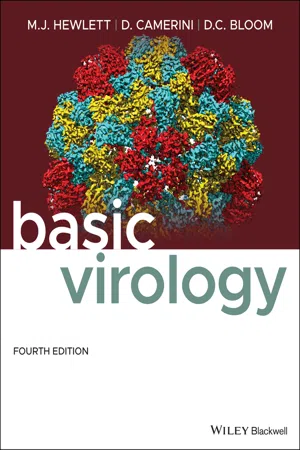
- English
- ePUB (mobile friendly)
- Available on iOS & Android
Basic Virology
About this book
The foundational textbook on the study of virology
Basic Virology, 4th Edition cements this series' position as the leading introductory virology textbook in the world. It's easily read style, outstanding figures, and comprehensive coverage of fundamental topics in virology all account for its immense popularity.
This undergraduate-accessible book covers all the foundational topics in virology, including:
- The basics of virology
- Virological techniques
- Molecular biology
- Pathogenesis of human viral disease
The 4th edition includes new information on the SARS, MERS and COVID-19 coronaviruses, hepatitis C virus, influenza virus, as well as HIV and Ebola. New virological techniques including bioinformatics and advances in viral therapies for human disease are also explored in-depth. The book also includes entirely new sections on metapneumoviruses, dengue virus, and the chikungunya virus.
Frequently asked questions
- Essential is ideal for learners and professionals who enjoy exploring a wide range of subjects. Access the Essential Library with 800,000+ trusted titles and best-sellers across business, personal growth, and the humanities. Includes unlimited reading time and Standard Read Aloud voice.
- Complete: Perfect for advanced learners and researchers needing full, unrestricted access. Unlock 1.4M+ books across hundreds of subjects, including academic and specialized titles. The Complete Plan also includes advanced features like Premium Read Aloud and Research Assistant.
Please note we cannot support devices running on iOS 13 and Android 7 or earlier. Learn more about using the app.
Information
PART I
Virology and Viral Disease
CHAPTER 1
Introduction – The Impact of Viruses on Our View of Life
THE SCIENCE OF VIROLOGY
The effect of virus infections on the host organism and populations – viral pathogenesis, virulence, and epidemiology
Table of contents
- Cover
- Table of Contents
- Dedication Page
- Title Page
- Copyright Page
- Preface to the First Edition
- Preface to the Second Edition
- Preface to the Third Edition
- Preface to the Fourth Edition
- Acknowledgments
- PART I: Virology and Viral Disease
- PART II: Basic Properties of Viruses and Virus–Cell Interaction
- PART III: Working with Virus
- PART IV: Replication Patterns of Specific Viruses
- PART V: Molecular Genetics of Viruses
- Appendix – Resource Center
- Technical Glossary
- Index
- End User License Agreement